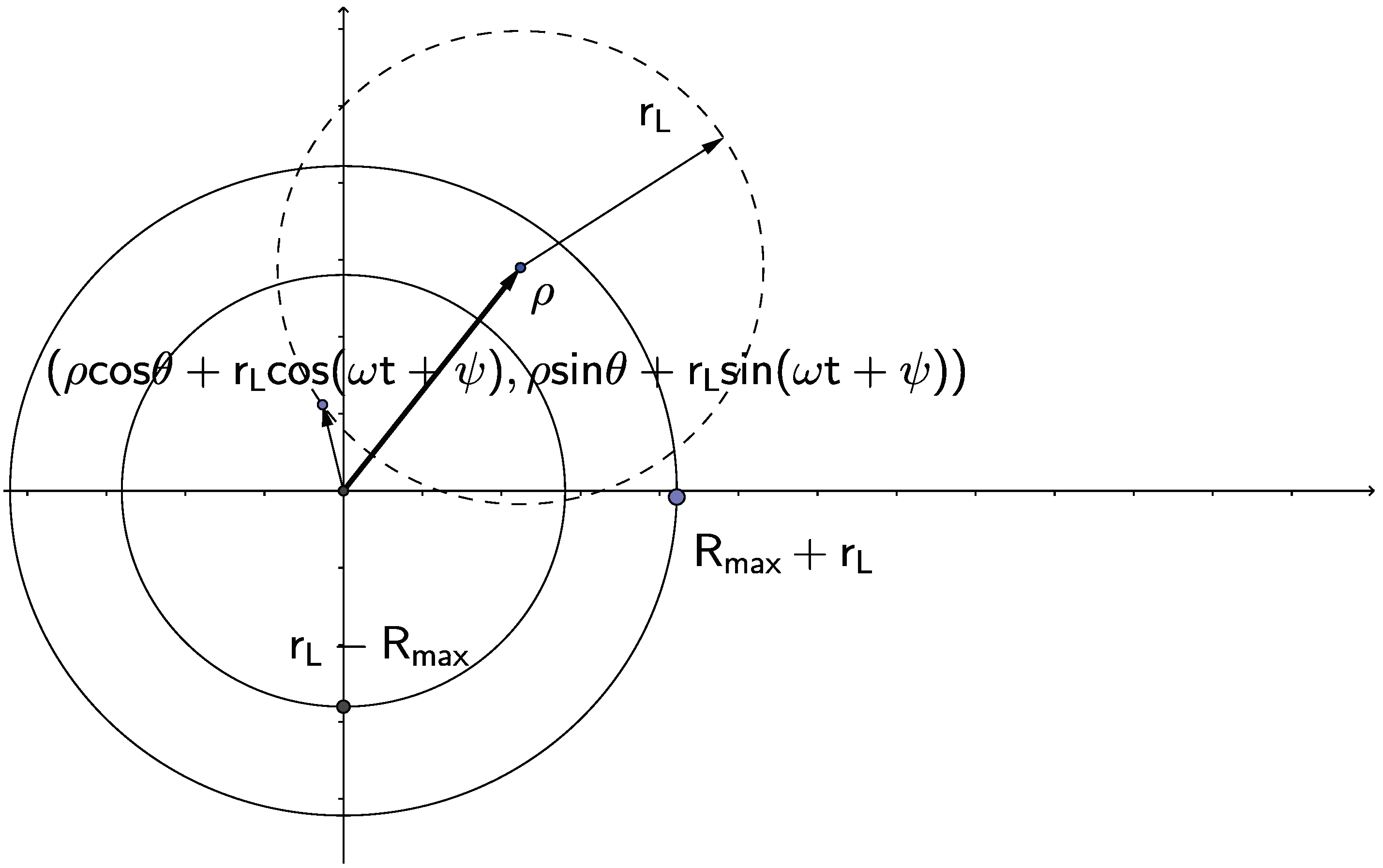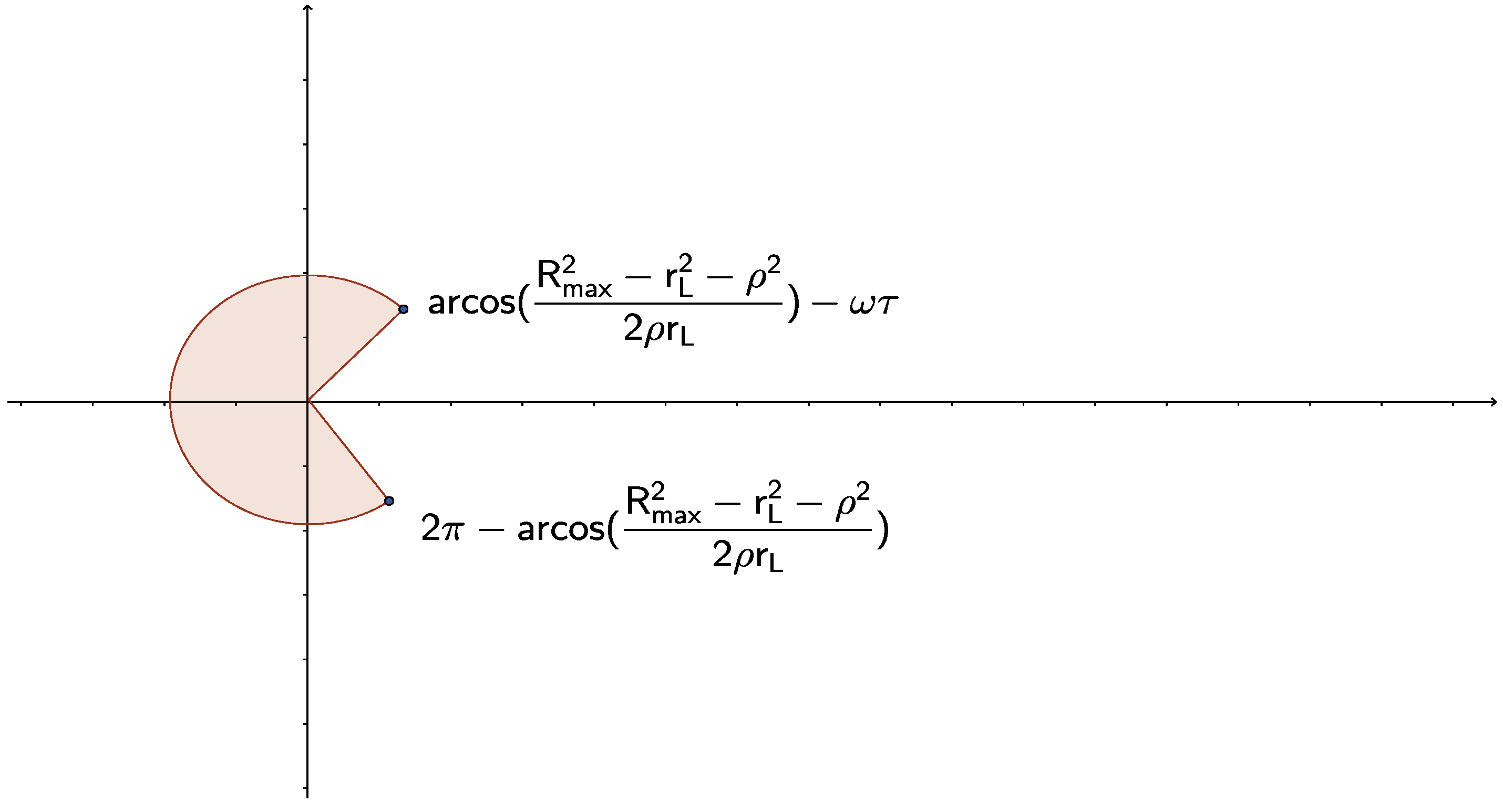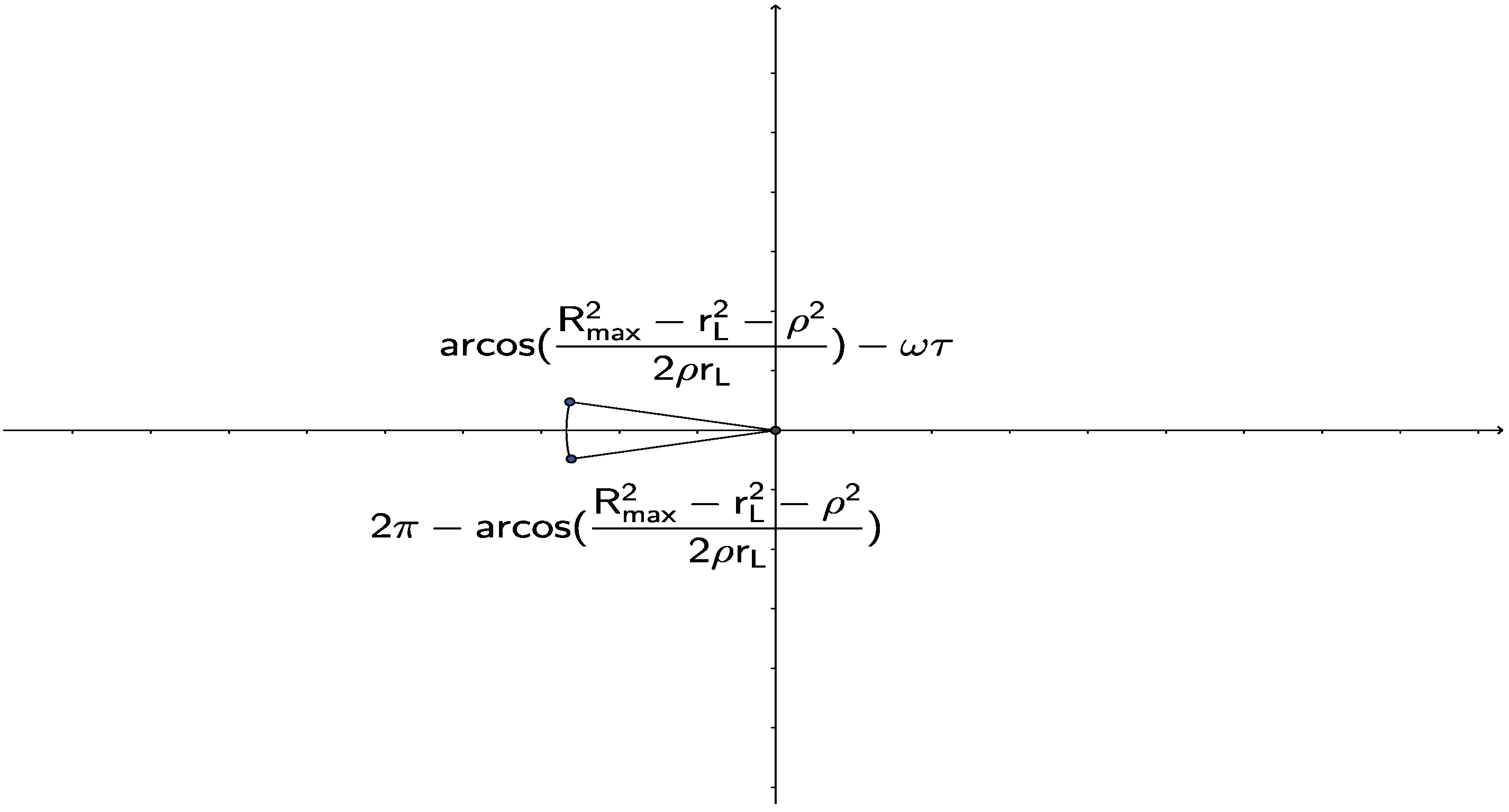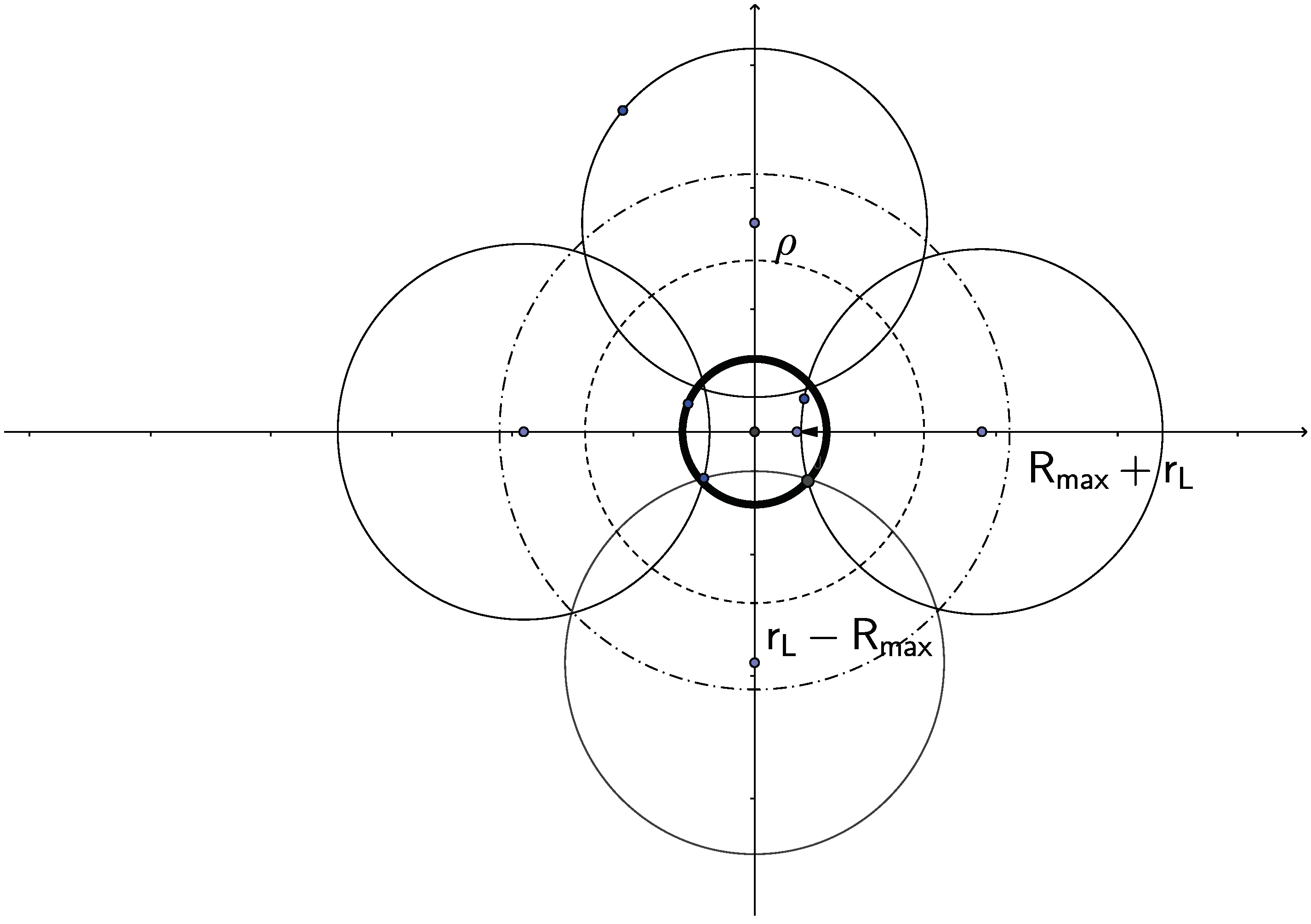We also consider a neutral emitter in this work.
2.1. Collision-Time Statistics
To include
and only the relevant perturbers, we use a modification of the collision-time statistics method of Hegerfeld and Kesting [
3] with Seidel’s improvement [
4]- see Ref. [
5] for details, as discussed in [
1].
As in [
1], perturbers move in a helical path characterized by the parallel constant velocity
, where the magnetic field direction defines the z-axis (passing through the emitter), the perpendicular velocity with magnitude
and impact parameter
, which is the distance of the center of the spiral to the z-axis, i.e., the perpendicular motion in the x-y plane is a circular motion with the Larmor radius
around the center
, with
the cyclotron frequency and Q the perturber charge. For the impact parameter
i.e., the impact parameter lies in a disk or annulus depending on whether the range
of the interaction, discussed below, is larger or smaller than
.
The relevant quantities for the helical trajectory
R(t) are as follows: The z-coordinate of the trajectory is
with
with the times of closest approach
representing the time the perturber trajectory intersects the x-y plane and being uniformly distributed.
thus represents how far from the x-y plane the perturber is at
t = 0.
Hence
where
describes the position of the impact parameter vector in the x-y plane and is uniformly distributed in (
).
is an angle describing where on the circular trajectory projection the perturber finds itself at
and is also uniformly distributed in (
) and ultimately related to the time the B-field was turned on. Each perturber is thus characterized by the vector
, or equivalently
instead of
.
As in [
1] we consider as “relevant " perturbers those that, at any time during the interval of interest (0,
), come closer to the emitter than a distance
, defined so that the interaction is negligible for distances larger than
. For a Debye interaction, we usually take
, where
denotes the shielding(Debye) length. This is because the interation becomes negligible (
for larger distances).
Therefore for a perturber to be relevant the condition
must hold for at least one time t in
, where
is the time of interest, i.e., a time large enough that the Fourier transform of the line profile
has decayed to negligible levels, or an asymptotic form is identifiable.
is a linear combination of products of time evolution operators (U-matrices) of the upper and lower levels. These time evolution operators -needed for times
- are determined by solving the Schroedinger equation in the Debye-shielded field
. Therefore a particle will only be relevant if for at least one time in the interval [0,
] it comes closer than
to the emitter(if not, then the perturbation produced by that particle is negligible due to Debye screening), which means that for at least
time
t in [0,
]:
Thus we generate
and
as before, but also draw
, uniformly distributed in (
as illustrated in in
Figure 1 and effectively only accept perturbers if, for at least one time in (0,
) Equation (
6) is satisfied. The
value of the LHS occurs for
. This in general imposes
(i.e., not all
contribute for a given
) on the values of
and
that a perturber can have and still contribute effectively to broadening, specifically:
If
and
,
and Equation (
6) is satisfied for
for
and
. Therefore in this case we have no restriction and
and
can independently take any value.
In all other cases, Equation (
6) results in the restriction:
Note that for Case b, the argument of the inverse cosine is absolutely ≤1. Specifically:
The left of the inequality follows because
alone. The right part also follows since
For
, Equation (
9) is also valid since
, as is Equation (
10). Since, as already discussed the case
imposes no restriction, we only consider here the case
, which implies
. It thus remains to show that
which follows from
.
Thus
For
, Equation (
6) is satisfied for
for any
and
and there is no restriction on
and
.
In all other cases, the restriction imposed by Equation (
7) applies and the argument of the inverse cosine is always absolutely
.
Hence the angle difference
must be in the shaded area shown in
Figure 2. So for at least one time
t in (
), the following must hold for the perturber with parameters
to contribute:
i.e.,
or
The net result is that for each
, only a a range of
,
contributes (this means that a fraction
contributes compared to the simplified case discussed in the previous work, i.e., the collision volume is smaller by
). If this is
we effectively have rectilinear trajectories for the time of interest. If this turns out to be larger than
, we have a full revolution and we can use the simplified formulas discussed in [
1]. As mentioned, we are mainly interested in the situation where
and
, as this is the case of large
, but slow
, otherwise the relation between
and
is always satisfied for at least one
t in
.
We can use the variable with and write the argument of the inverse cosine as
Note that for low B (large
) this tends to −1, hence the inverse cosine is close to
. This means that in this limit
, e.g., we get a
(but note that in that limit we had divergencies in the relevant functions when computing the collision volume in [
1]).
This situation is depicted in
Figure 3, which shows the typical situation for the phase space of the quantity
that contributes. This is also illustrated in
Figure 4, which shows, for the same
, 4 different angles
, which determine the centers of the spirals and the parts of the circular projections of these spirals that are effective. For instance if the center of the spiral, i.e., the vector of the impact parameter is the the right (
), then
(the leftmost of the circular trajectory projection) for
. Similarly, if the impact parameter vector is to the south (
), then the relevant
is to the north of the circular trajectory projection, e.g.,
).
In the limit (or infinite perturber mass), and we get from the and integrations a term .
2.2. Collision Volume
The collision-time statistics method first computes the number of relevant particles, i.e., the density times the relevant volume, i.e., the above cylinder. This volume is as before [
1], except that we also account for the polar angle
, describing the orientation of the impact parameter with respect to the x-axis and the angle
describing the position of the particle on the perpendicular x-y plane at time
, i.e., we have the extra integrations
. The
integration simply returns a factor of 1 if
, but it does so even under the weaker condition
, or
Otherwise it gives a factor of
with
defined in Equation (
15).
The nonnegative root of Equation (
17) is
i.e., the results of [
1] are also valid for
, which in turn requires that
(else
), which also guarantees the reality of
, i.e.,
The
angular integration simply returns 1 in either case. As a result, the results of [
1] need
for
. Otherwise, the collision volume calculation runs as follows:
For , i.e., , . However, as already discussed, this is valid (e.g., no restriction on is required ) also for , hence for .
For small
and
is the maximum of the two. The collision volume reads:
with
and
denoting a one and two-dimensional Maxwellian velocity distributions respectively and with
redefined as in
Table 1:
and
are:
with
The integrals
are given explicitly below. However, we first define the dimensionless quantities:
and
and
(essentialy the averaged inverse s
).
and
while
with
with
and
being of course functions of
x.
and
Note that the
difference from the previous work [
1] is the factor
for
. Also note that in [
1], the corresponding integrations to infinity, e.g., the equivalents of
and
diverged as
. This divergence has been eliminated here due to the
factor. This is shown in
Appendix A, which evaluates the
and
integrals.
The remaining contributions vanished in [
1] as
and clearly continue to do so here.
As already mentioned in [
1], the number of particles that are in this volume, and hence need to be simulated, is simply the volume multiplied by the perturber density.
2.3. Generating Perturbers
To generate perturbers we proceed as in [
1], but also generate for each perturber an angle
, uniformly distributed in (0,
). Once we have generated
and
, we also generate
uniformly distributed in
.
In more detail, we first draw a random number uniformly distributed in (0,1). If this is smaller than , then we generate from the distribution by generating independently a with the probability distribution , a with the probability distribution and a with the probability density in .
Otherwise we generate from the distribution . The generation of impact parameters was done by a rejection method, as straightforward inversion is not possible.
Once and have been generated, is selected as a uniformly distributed time in . and are also generated as discussed above.









